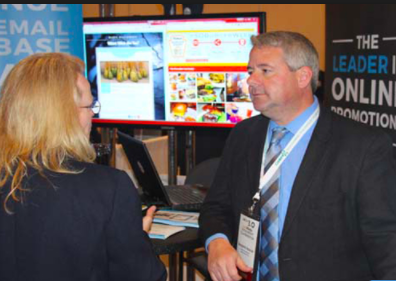
How media purchase technology and why
You know your platform can help customers transform their company and grow revenues.
But. how much do you know about the process your customers go through when they make a decision to purchase a software platform? And if you don’t know, how can you be good enough at marketing to deliver real leads at scale?
So, note to all the geeks in the room, listen to the data.
1. Executives don’t want to use a sales rep to “keep up” on technology options
The role of your sales person barely registers in the discovery stage (5%, Walker Sands).
Print trade magazines were also not used by more than 75% of purchasers (IDG).
And few ( 7% Walker Sands) of B2B buyers say social media influenced them at any stage of the sale and more than half said it had no influence at all, in spite of its use by 72% of tech marketers.
So if they do not want inbound sales emails and calls, or print, or social, just what are they using for discovery?
Decision-makers actually ‘keep up’ in the pre-search phase with multiple (up to ten) sources (IDG survey of IT purchasers, September, 2016) of information.
Five most used are: 1. Independent news and reviews (66%) 2. White papers (58)3. Webinars (58%) 4. Newsletters (47%) 5. Technology vendor websites (48%). If you combine internal and external peer recommendations that makes up 73%. The good news is that while, independent news and reviews are preferred, executives are heavily using vendor content as well.
Part of the content marketing strategy should be aimed at instigating a search in the discovery phase.
2. The purchasing process varies by company size
This will come as no surprise. In smaller companies the decision-making is typically more centralised, in larger ones it may be more distributed. A 2015 recently-released study from SiriusDecisions divides buyers into three tiers, Independent, Consensus and Committee.
Mostly the larger the company, the more centralized. Media companies may be a bit of a hold-out: one owner of 300 newspapers allows each to make its own decisions on platforms used.
A corporate VP still leads by finding a couple of BETA markets for important initiatives, which they know others will follow if it is successful.
However, in general, this is the exception to the rule. What is important is to understand the customer. But in the aggregate, the data clearly shows that larger sale, the more people, time, and influences are involved:
- The number influencers grows. Small companies may have one or two, large corporations may have ten to 35 or more stakeholders weighing in on the plan.
- The sales cycle lengthens. Sales to owner-operated companies can take place in a month. A large corporation can take up to a year
- The more human and non-human content-oriented interactions are involved. Think of passive interactions as visits to your website or reads of an email. Content plans should be crafted to increase these contacts, and include message important to larger buyers such as time in business, ability to ‘keep up’ long term with new iterations, case studies and ease of implementation.
Best practice is to use create customer personas (start here) to fully understand each type of buyer, and incorporate their motivators and obstacles into your content marketing plan
3. Once engaged in research, purchasers rely heavily on sales people
IDG’s 2016 survey of IT Purchasers (both hardware and software) shows that purchasers are very involved in using sales reps to help them research. So what do they want from reps? A lot!
- Speedy answers(67%).
- Free trials and test drives (64%).
- Advice and best practices (52%).
- Case studies (50%)
- Educational assets and references (46%).
- Ask them questions and show ROI (30%).
They dislike direct sales pitches. Part of your content marketing plan should be to create the internal materials that your sales people have at the ready, including information in one sheet that is only given verbally, such as side-by-side comparisons with key competitors. The moral of the story is this: Don´t wait until the customer asks for data Have the information on hand.
4. Executives are most influenced to make a purchase by Product Demos (52%) and Case studies/testimonials (47%) (Walker Sands).
In fact case studies/testimonials were the most important factor for VP/Directors and Coordinators, followed by the product demos. The reverse was true at the C-level.
Videos (15%) and webinars (14%) are further down the list of what was most “influential.” They are clearly important in the discovery and research phase, but do not have the same kind of final impact on the final sale.
We recommend two client case-studies per vertical, each focusing on a different client type, such as small or large, mature or rapidly growing. Best practice is also to build client case studies into your demos and webinars. Demo´s should be flexible enough to use the right customer type that matches your prospect.
Again, a lot of pre-planning of your content strategy goes a long way when it comes time for the purchase.
5. Price and ease of use were cited as the most important factors in the purchase decision, (Walker Sands).
Interestingly, the CTO´s said ease of use was most important, possibly because they are ultimately responsible for internal customer service issues, while COO´s wanted to know more about price.
One of our customers has a higher price point that is more than justified by the ROI, ease of use and other metrics. They contacted us after mysteriously losing a sale to a lower-priced competitor. Today, the actual value is baked into all of their content, demos and webinars and they nave not lost a single customer to a competitive bid.
6. Budgets, difficulty of implementation and internal resistance are the largest obstacles to purchase
A study of marketing technology purchasers (Walker Sands), shows that turn downs typically come from one of these three factors.
Opinions of colleague and peers are important, including the opinions of non-C level employees ( MarketingCharts). What difficult about this is that, like the mysterious lost sale mentioned above, your sales VP may never know who or why a prospect ultimately nixed the deal.
As in the pre-search phase, the influence of sales reps is negligible when the decisions are being made.
The purchasing company turns inward and talks to itself. Your team may never even know ‘what went wrong,’ but it was probably one of these three factors.
Again, once you know which of these obstacles are most important (include them in your customer persona) to your client types, incorporate your answers to obstacles into the case studies, demos, press releases and webinars. If budget is the issue, focus on a high impact ROI or cost saving number from a real client.
Be specific, such as sales growth of 300% YOY, or savings of two FTE´s. If easy of implementation is an issue, a great testimonial or case study showing days to complete and positive feedback from the internal team should stave off a future ‘We decided to take a pass’ conversion.
If you are having trouble obtaining real client case studies, ask about our awards programs that recognize clients for best practices. For data sources, please scroll past the form.
Information sources
- IDG Survey of IT Purchasers, September 2016 (IDG). This is a directly related study across IT industry including hardware and software.
- Walker Sands study, which surveyed 313 U.S. corporations in 2016 to find how they made a decision to purchase a marketing technology platforms.
- Marketing Charts – They provide a variety of surveys on B2B purchasers. (MC)
- 2015, Regalix survey of 640 senior marketing executives and business leaders about their product marketing practices from a range of B2B technology companies (software, hardware, cloud computing, and mobile).
- A 2015 recently-released study from SiriusDecisions (Sirius)






Comments are closed.